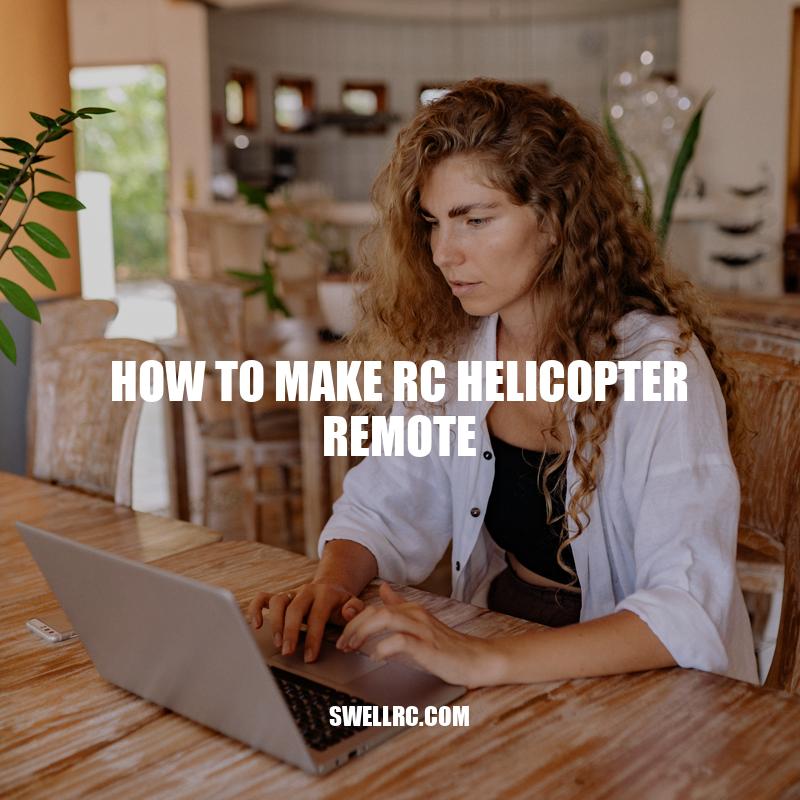DIY Guide: Make Your Own RC Helicopter Remote
Do you have a passion for remote-controlled helicopters and want to take your hobby to the next level? One of the most important components of an RC helicopter is the remote control, also known as the transmitter. The remote control is the device that allows you to control and maneuver the helicopter in the air. However, purchasing a high-quality remote control can be expensive, especially if you’re on a budget. If you want to save some money and take on a new challenge, making your own remote control may be the perfect solution. Making your own remote control not only saves you money but also gives you the satisfaction of creating something with your own hands. Plus, it allows you to customize it to your liking and ensure that it has all the features that you need for your helicopter. While making an RC helicopter remote control may seem complicated at first, with the right tools, materials, and instructions, it can be easy and fun. In this article, we’ll guide you on how to make your own RC helicopter remote control step-by-step, so you can get started on your new project today.
Gather Materials
Before starting to create your remote control, you will need to gather the necessary tools and materials. Here are the essential items you’ll need for your DIY RC helicopter remote:
- Microcontroller – the brain of the remote control
- Transmitter – sends signals to the helicopter
- Receiver – receives signals from the remote control
- Electronic Speed Controller (ESC) – controls the motor speed
- Potentiometer – controls direction and speed
- Joystick or switch – sends signals to the transmitter
- Free-wheeling diode – prevents electrical spikes from damaging the remote
- 9-volt battery – powers the remote control
- Wire cutters/strippers – used to cut and strip wires
- Soldering iron – used to solder the components together
- Solder – used to connect the parts together
You can purchase these items from electronics stores or online retailers like Amazon or Fry’s Electronics. Don’t cut corners when selecting the materials for your remote control as the quality of the materials will affect the overall performance of your RC helicopter remote.
What materials do you need to make a helicopter?
To make a helicopter, you need various materials such as:
- Aluminum or composite for the body and rotor blades
- Steel or titanium for the engine, transmission, and landing gear
- Wires, cables, and pulleys for the control system
- Avionics equipment for the navigation and communication system
Building a helicopter requires a specific set of skills and expertise. If you’re interested in learning more about the process, you can check out websites such as robinsonheli.com or blueprintengines.com/helicopter-engines/.
Building the Remote Control
Now that you have all of the necessary materials, it’s time to build your RC helicopter remote control. Here are the steps to build your remote control:
| Step | Description |
|---|---|
| Step 1 | Connect the microcontroller to the transmitter and determine their optimum mounting positions |
| Step 2 | Attach the receiver, ESC, and potentiometer to the microcontroller |
| Step 3 | Connect the joystick or switch to the transmitter and solder the wiring together |
| Step 4 | Add the free-wheeling diode to prevent electrical spikes from damaging your remote |
| Step 5 | Attach the battery to the microcontroller and double-check all of the wiring and connections |
When building your remote control, be sure to keep it neat and tidy. A messy and disorganized remote control can lead to electrical shorts and can hinder the performance of the remote. Take extra care when connecting the wires to ensure that they are placed in the correct position and don’t touch one another.
Interesting fact: The first remote controls were developed by RCA in the late 1940s for their television sets.
How to make RC helicopter instructables?
To create RC helicopter instructables, follow these steps:
- Choose a topic or theme for your instructables.
- Choose the appropriate RC helicopter for your project.
- Take clear and detailed photos throughout the project.
- Write clear and concise instructions for each step of the project.
- Include safety precautions and warnings where necessary.
- Proofread and edit your instructables for accuracy and clarity.
- Upload your instructables to websites such as Instructables.com or RC Groups.com for others to view and learn from.
Testing the RC Helicopter Remote
Testing is a necessary step when building an RC helicopter remote control. Here are some tips for testing your remote control:
- Conduct a few preflight checks to ensure that everything is working properly.
- Test the control range of your remote by gradually increasing the distance between the remote and the helicopter. The distance should be within the effective range of the remote.
- Check for any interference from other electronic devices or obstacles that may affect the signal transmission of the remote.
- Test the stability and functionality of the remote by trying all of its functions and features.
It is recommended to have a few spare batteries on hand when testing your remote control. Any electronic device may have issues that can only be detected over time or after extensive use, so it’s important to make sure that your remote control is working correctly before using it to operate your RC helicopter.
Conclusion
If you’re interested in flying RC helicopters, building your own remote control can be a fun and rewarding experience. By following the steps outlined above and testing your remote control before use, you can be sure that you have a reliable and stable control for your RC helicopter. Remember to use quality materials and to follow safety precautions when building your remote control. Additionally, it’s always a good idea to do plenty of research and consult with experienced hobbyists to ensure that you’re building the best remote control for your needs. With a custom-made remote control, you’ll be able to enjoy a truly unique flying experience.



